today we will be studying friction and by the end you will be enrich with all the concept of physics
i found it interesting so for the expansion of knowledge i copied from one ebook but really i have also done some modification two it .
that was in very high level language but i change it to simper form.
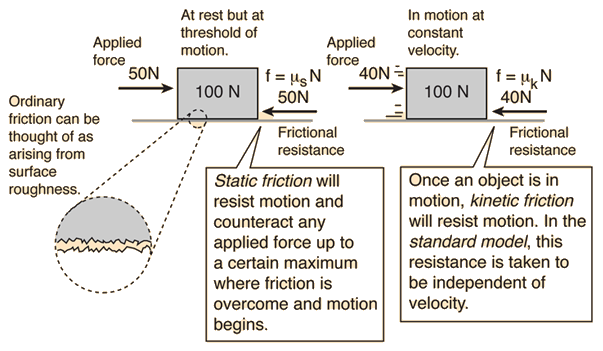
Like all simple statements about friction, this picture of friction is too simplistic. Saying that rougher surfaces experience more friction sounds safe enough - two pieces of coarse sandpaper will obviously be harder to move relative to each other than two pieces of fine sandpaper. But if two pieces of flat metal are made progressively smoother, you will reach a point where the resistance to relative movement increases. If you make them very flat and smooth, and remove all surface contaminants in a vacuum, the smooth flat surfaces will actually adhere to each other, making what is called a "cold weld". Once you reach a certain degree of mechanical smoothness, the frictional resistance is found to depend on the nature of the molecular forces in the area of contact, so that substances of comparable "smoothness" can have significantly different coefficients of friction.
An easily observed counterexample to the idea that rougher surfaces exhibit more friction is that of ground glass versus smooth glass. Smooth glass plates in contact exhibit much more frictional resistance to relative motion than the rougher ground glass.
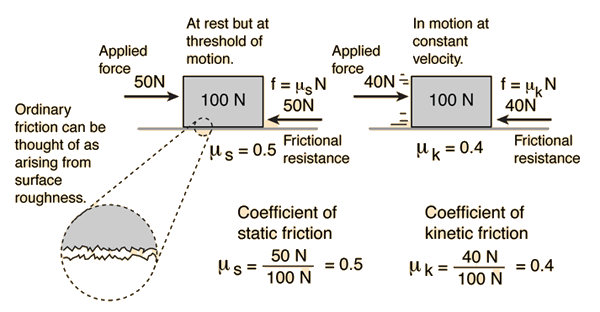 Note that the static friction coefficient does not characterize static friction in general, but represents the conditions at the threshold of motion only
Note that the static friction coefficient does not characterize static friction in general, but represents the conditions at the threshold of motion only


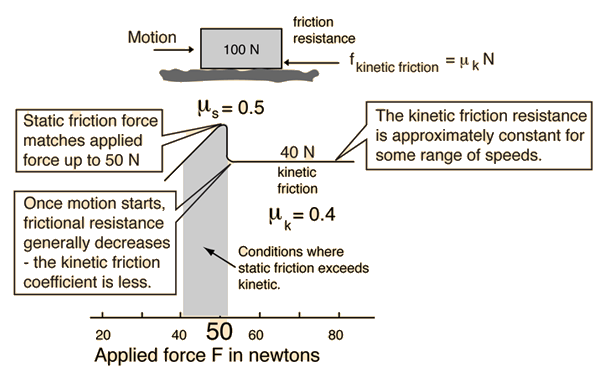
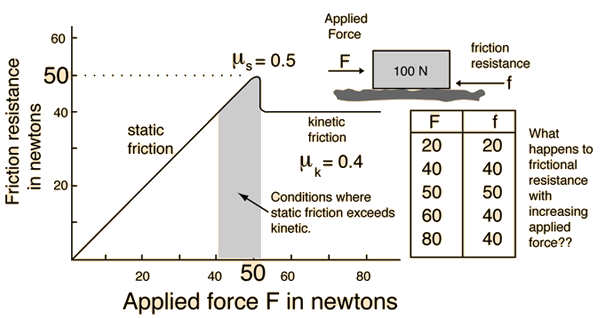

When carefully standardized surfaces are used to measure the friction coefficients, the difference between static and kinetic coefficients tends to disappear, indicating that the difference may have to do with irregular surfaces, impurities, or other factors which can be frustratingly non-reproducible. To quote a view counter to the above model of friction:
"Many people believe that the friction to be overcome to get something started (static friction) exceeds the force required to keep it sliding (sliding friction), but with dry metals it is very hard to show any difference. The opinion probably arises from experiences where small bits of oil or lubricant are present, or where blocks, for example, are supported by springs or other flexible supports so that they appear to bind." R. P. Feynman, R. P. Leighton, and M. Sands, The Feynman Lectures on Physics, Vol. I, p. 12-5, Addison-Wesley, 1964

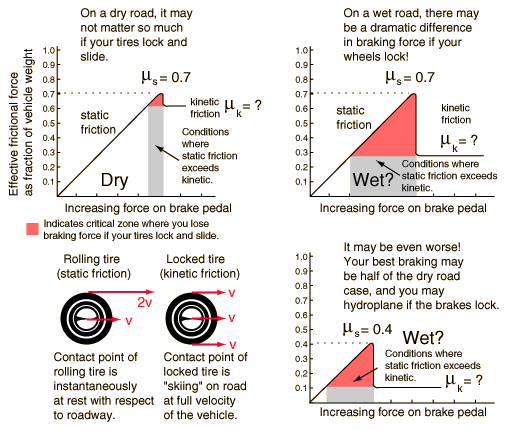
i found it interesting so for the expansion of knowledge i copied from one ebook but really i have also done some modification two it .
that was in very high level language but i change it to simper form.
Friction
Frictional resistance to the relative motion of two solid objects is usually proportional to the force which presses the surfaces together as well as theroughness of the surfaces. Since it is the force perpendicular or "normal" to the surfaces which affects the frictional resistance, this force is typically called the "normal force" and designated by N. The frictional resistance force may then be written:
| &mu = coefficient of friction &muk = coefficient of kinetic friction &mus = coefficient of static friction |
Standard model
|
The frictional force is also presumed to be proportional to the coefficient of friction. However, the amount of force required to move an object starting from rest is usually greater than the force required to keep it moving at constant velocity once it is started. Therefore two coefficients of friction are sometimes quoted for a given pair of surfaces - a coefficient of static friction and a coefficent of kinetic friction. The force expression above can be called the standard model of surface friction and is dependent upon several assumptions about friction.
While this general description of friction (which I will refer to as the standard model) has practical utility, it is by no means a precise description of friction. Friction is in fact a very complex phenomenon which cannot be represented by a simple model. Almost every simple statement you make about friction can be countered with specific examples to the contrary. Saying that rougher surfaces experience more friction sounds safe enough - two pieces of coarse sandpaper will obviously be harder to move relative to each other than two pieces of fine sandpaper. But if two pieces of flat metal are made progressively smoother, you will reach a point where the resistance to relative movement increases. If you make them very flat and smooth, and remove all surface contaminants in a vacuum, the smooth flat surfaces will actually adhere to each other, making what is called a "cold weld".
Friction and Surface Roughness

Like all simple statements about friction, this picture of friction is too simplistic. Saying that rougher surfaces experience more friction sounds safe enough - two pieces of coarse sandpaper will obviously be harder to move relative to each other than two pieces of fine sandpaper. But if two pieces of flat metal are made progressively smoother, you will reach a point where the resistance to relative movement increases. If you make them very flat and smooth, and remove all surface contaminants in a vacuum, the smooth flat surfaces will actually adhere to each other, making what is called a "cold weld". Once you reach a certain degree of mechanical smoothness, the frictional resistance is found to depend on the nature of the molecular forces in the area of contact, so that substances of comparable "smoothness" can have significantly different coefficients of friction.
An easily observed counterexample to the idea that rougher surfaces exhibit more friction is that of ground glass versus smooth glass. Smooth glass plates in contact exhibit much more frictional resistance to relative motion than the rougher ground glass.
Coefficients of Friction
Friction is typically characterized by a coefficient of friction which is the ratio of the frictional resistance force to the normal force which presses the surfaces together. In this case the normal force is the weight of the block. Typically there is a significant difference between the coefficients of static friction and kinetic friction. Note that the static friction coefficient does not characterize static friction in general, but represents the conditions at the threshold of motion only
Note that the static friction coefficient does not characterize static friction in general, but represents the conditions at the threshold of motion onlyNormal Force
Frictional resistance forces are typically proportional to the force which presses the surfaces together. This force which will affect frictional resistance is the component of applied force which acts perpendicular or "normal" to the surfaces which are in contact and is typically referred to as the normal force. In many common situations, the normal force is just the weight of the object which is sitting on some surface, but if an object is on an incline or has components of applied force perpendicular to the surface, then it is not equal to the weight.
Static Friction
Static frictional forces from the interlocking of the irregularities of two surfaces will increase to prevent any relative motion up until some limit where motion occurs. It is that threshold of motion which is characterized by the coefficient of static friction. The coefficient of static friction is typically larger than the coefficient of kinetic friction.

In making a distinction between static and kinetic coefficients of friction, we are dealing with an aspect of "real world" common experience with a phenomenon which cannot be simply characterized. The difference between static and kinetic coefficients obtained in simple experiments like wooden blocks sliding on wooden inclines roughly follows the model depicted in the friction plot from which the illustration above is taken. This difference may arise from irregularities, surface contaminants, etc. which defy precise description. When such experiments are carried out with smooth metal blocks which are carefully cleaned, the difference between static and kinetic coefficients tends to disappear. When coefficients of friction are quoted for specific surface combinations are quoted, it is the kinetic coefficient which is generally quoted since it is the more reliable number.
Kinetic Friction
When two surfaces are moving with respect to one another, the frictional resistance is almost constant over a wide range of low speeds, and in the standard model of friction the frictional force is described by the relationship below. The coefficient is typically less than the coefficient of static friction, reflecting the common experience that it is easier to keep something in motion across a horizontal surface than to start it in motion from rest.
Friction Plot
Static friction resistance will match the applied force up until the threshold of motion. Then the kinetic frictional resistance stays about constant. This plot illustrates the standard model of friction.

When carefully standardized surfaces are used to measure the friction coefficients, the difference between static and kinetic coefficients tends to disappear, indicating that the difference may have to do with irregular surfaces, impurities, or other factors which can be frustratingly non-reproducible. To quote a view counter to the above model of friction:
"Many people believe that the friction to be overcome to get something started (static friction) exceeds the force required to keep it sliding (sliding friction), but with dry metals it is very hard to show any difference. The opinion probably arises from experiences where small bits of oil or lubricant are present, or where blocks, for example, are supported by springs or other flexible supports so that they appear to bind." R. P. Feynman, R. P. Leighton, and M. Sands, The Feynman Lectures on Physics, Vol. I, p. 12-5, Addison-Wesley, 1964
Rolling Friction
A rolling wheel requires a certain amount of friction so that the point of contact of the wheel with the surface will not slip. The amount of traction which can be obtained for an auto tire is determined by the coefficient of static friction between the tire and the road. If the wheel is locked and sliding, the force of friction is determined by the coefficient of kinetic friction and is usually significantly less.
Assuming that a wheel is rolling without slipping, the surface friction does no work against the motion of the wheel and no energy is lost at that point. However, there is some loss of energy and some deceleration from friction for any real wheel, and this is sometimes referred to as rolling friction. It is partly friction at the axle and can be partly due to flexing of the wheel which will dissipate some energy. Figures of 0.02 to 0.06 have been reported as effective coefficients of rolling friction for automobile tires, compared to about 0.8 for the maximum static friction coefficient between the tire and the road.
Maximum Speed on Banked Roadway

The concepts used in this analysis included Newton's second law, centripetal acceleration, static friction, and the division of vectors into components. The horizontal components of the friction and normal force are constrained to provide the centripetal acceleration in the x direction to keep the car moving in a circle. The sum of the y components of all the forces must be zero since there is no acceleration in that direction.
Friction and Automobile Tires
| The friction between the tires of your automobile and the road determine your maximum acceleration, and more importantly your minimum stopping distance. So the nature of that friction could actually be a matter of life and death. But like all applications of friction, it has frustrating ambiguities. Many years of research and practice have led to tread designs for automobile tires which offer good traction in a wide variety of conditions. The tread designs channel water away from the bearing surfaces on wet roads to combat the tendency to hydroplane - a condition which allows your car to "ski' on the road surface because you have a layer of water lubricant under all parts of your tire. |  |
Jones and Childers report coefficients of friction of about 0.7 for dry roads and 0.4 for wet roads. The tread design represents an "all weather" compromise. If you were an Indianapolis race driver, you would use "slick" racing tires with no tread. On dry surfaces you might get as high as 0.9 as a coefficient of friction, but driving them on wet roads would be dangerous since the wet road coefficient might be as low as 0.1 .
Sooner or later, most people have to deal with the tricky judgment of how hard to put on the brakes in an emergency stop. It is a difficult issue, and no final answers are given here. But the illustration below may point out some of the relevant physical principles involved. In the best case scenario, you should keep your wheels rolling while braking because the bottom point of the tire is instantaneously at rest with respect to the roadway (not slipping), and if there is a significant difference between static and kinetic friction, you will get more braking force that way. But you generally don't have the luxury of time to make a delicate judgment about how hard to put on the brakes. For good tires on dry surfaces, there is not much difference between rolling and sliding friction, and if you back off the braking force very much, you will get less braking than if you just locked them down. The other issue is that in an extreme emergency, the braking is instinctive and you tend to hit the brakes as hard as you can before you can even think about it.
Maybe locking the brakes is not so bad in good conditions on the dry road, and you may not be able to keep from doing so in an extreme emergency. But if you lock the wheels on a wet road, the results could be disastrous! I don't have anything like reliable estimates of the effective coefficient of friction, but I am guessing that it could easily drop to less than half of the "wheels rolling" braking because you are sliding on a surface which is lubricated by water. It may be that even with wheels rolling you might have in the neighborhood of 0.4 as a coefficient compared to 0.7 on the dry road, and it might drop down to the 0.1 of the slick tire. Those scary scenarios are depicted below in a qualitative way - I don't have reliable numbers.

No comments:
Post a Comment